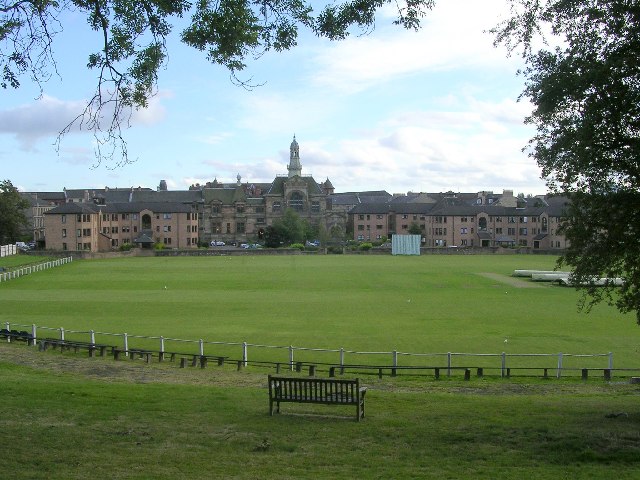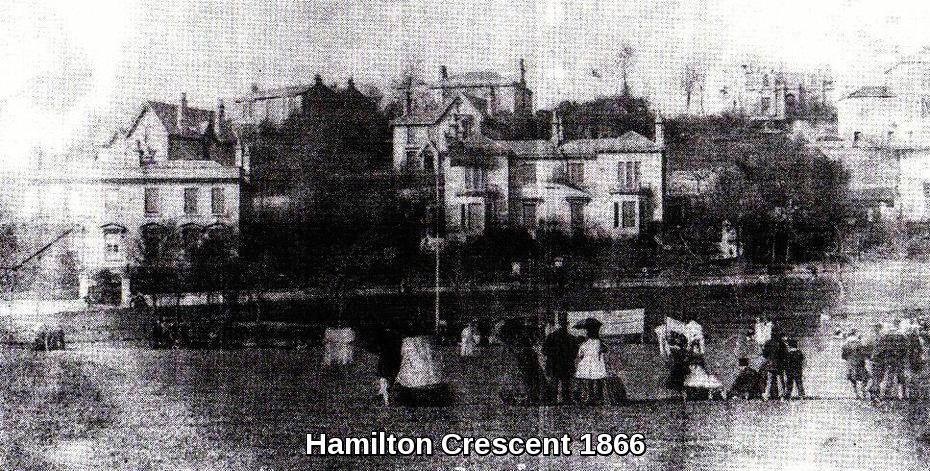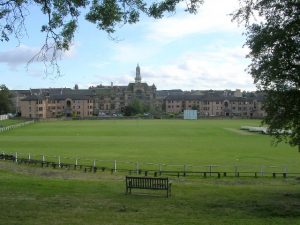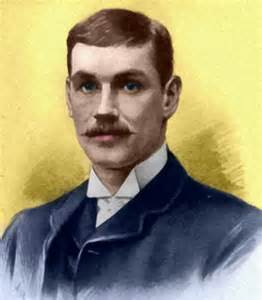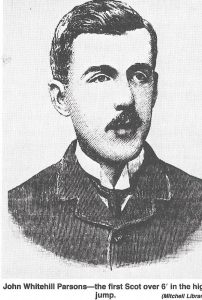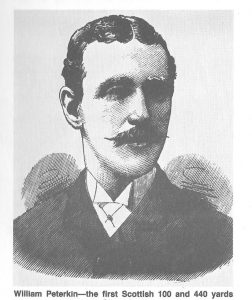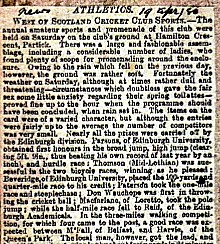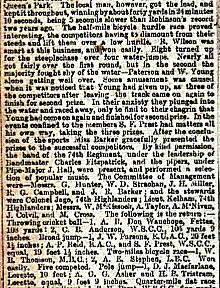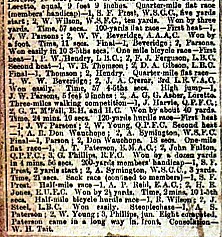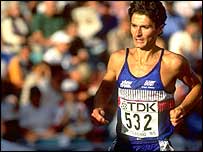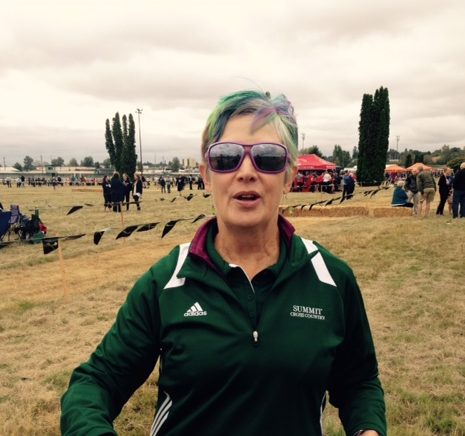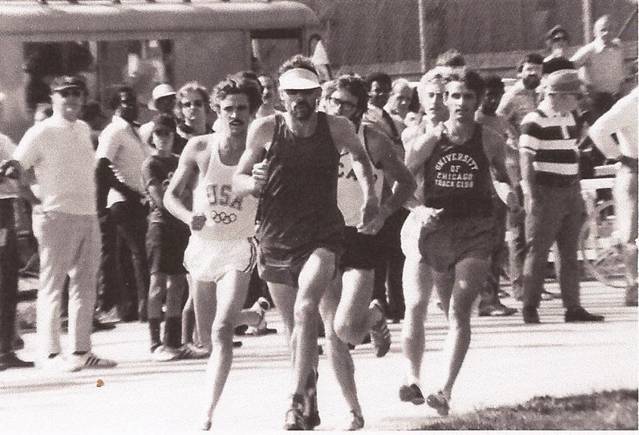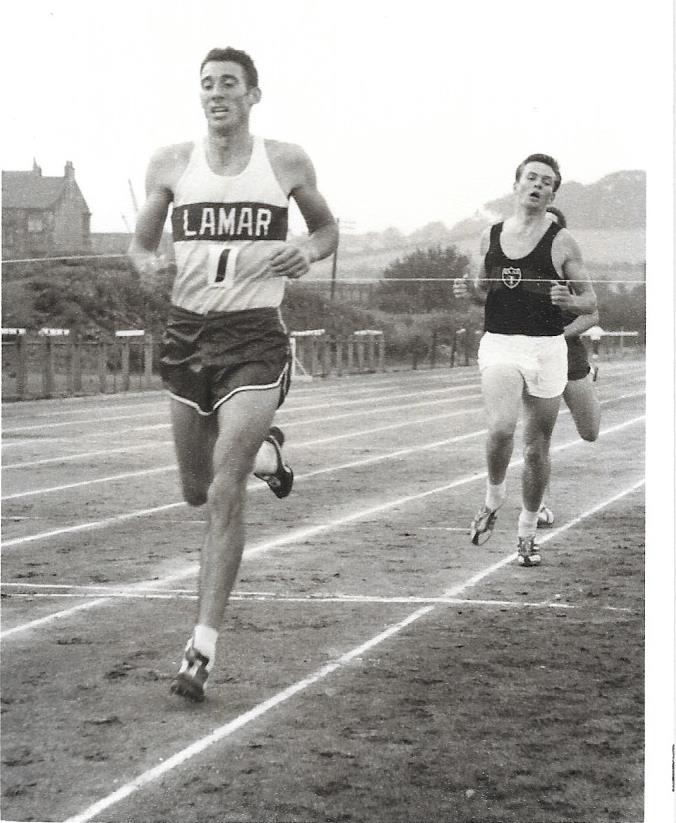The West of Scotland Cricket Club ground at Hamilton Crescent, Partick, Glasgow
When looking at the start of amateur athletics in Scotland and the organisations that helped it grow and thrive and develop into the major sport that it became, many see the great contribution made by football clubs right up into the 1960’s, and assume that that is all there was. Not True. Other sports played a part and cricket was one of them. Their contribution should not be forgotten: in the 19th century it was a major sport in Scotland with many top class clubs operating right across the country. Pages were devoted on Monday mornings in the Press to their weekend matches. They all had their own grounds, they had top class athletes competing for them and it was natural that they put on a sports meeting. One of the biggest, if not the biggest, was the one put on every April by the West of Scotland Cricket Club at their Hamilton Crescent ground in the west of Glasgow. The club was formed in 1862. and their sports were usually, but not always, held on the third Saturday in April. This may seem a strange time to hold a summer sports meeting but given that cricket was at the time the major summer sport in the country, it would have been sensible to have it at the start of the season when their men were in good condition for the battles ahead.
*
The results for the earliest days are not at present available so we will start then in 1870 and the event was held on the 2nd April that year and the Herald tells us that the events held were throwing the cricket ball, the running high jump, running long jump, the 440 yards for school pupils, 100 yards, 440 yards handicap confned to WSCC members, Garrison race. mile race, three legged race, 200 yards race, steeplechase over four fences and four water jumps, and consolation stakes. The report from the ‘Glasgow Herald’ read, under the heading
WEST OF SCOTLAND CRICKET CLUB ATHLETIC SPORTS’:
“On Saturday afternoon the annual athletic sports and promenade in connection with the WestOf Scotland Cricket Club took place n the club’s ground at Partick. The weather in the early part of the forenoon was bright and clear, but gradually several clouds made their appearance and a slight shower fell just about the time when the Games were to commence. For some time there was every appearance of a wet afternoon, but about half past three o’clock the dulness cleared away, and the sun shone out brightly so that the sports were brought to a close without anything having occurred to mar the enjoyment of the day. This annual meeting has been very much appreciated in former years; and on Saturday afternoon there was a very large and brilliant assemblage within the enclosure, and these seemed to take a deep interest in each race. The programme was all timed and carried out leisurely. The arrangements of the sewards was excellent and everything went off with great eclat. Some of the races were very exciting and the great event of the day was the steeplechase where within 760 yards, there were four hurdles and four water jumps to clear. For the honour of gaining this race, five competitors started. After a fair start, they ran well together until the first water jump, when four cleared it and only one got himself wet but, nothing daunted, he got out, and quickly caught his competitors. At the second water jump some of them went a header but scrambled out and got on good terms with the leaders. The exitement was now rising as it became evident that the next round would be the grand test. One runner retired, leaving four to fight for the laurels. At the third water jump, only one cleared the leap, but, not jumping the next hurdle was out of the race. At the fourth water jump they all went in, to the ausement of the spectators. Not withstanding the applause, another gave in within 160 yards of the winning post. This left only two to contend for victory, viz. Smith and Neilson. At the last hurdle, Neilson, who looked all over like winning, made a mistake and let in Smith who won by two yards – thus securing his second victory. By the kind permission of Colonel Bartley and the officers of the Regiment, the band of the 5th Fusiliers was present and played several excelent selections during the afternoon. Mr John Pattison efficiently discharged the duties of the starter, and the decisions of the various judges gave perfect satisfaction. We have also to thank Mr Penman for his attention to the members of the Press. Mr Robert Graeme also officiated as time keeper.”
This meeting was held thirteen years before the SAAA was founded and fifteen before the establishment of Clydesdale Harriers, Scotland’s first open athletics club. In the steeplechase, the four water jumps and four hurdles came in a race of less than half a mile and the water jumps were 12 feet across. At the end of proceedings, where Mr Peter White thanked the ‘assemblage’ for attending and the organisers for giving them a pleasant day’s ‘outing’ in a very pleasant spot. The prizes, reported to be very costly, many being ‘silver cups, jugs, etc’ , were presented by Miss Margaret K Brown.
In 1872 the Sports were held on 13th April and The Scotsman report appeared on the Monday. (It is maybe unfortunate that the coverage of the Glasgow club’s sports were covered better and more often by the Edinburgh paper than by the Glasgow Herald).
The Scotsman report on Monday 15th April, 1872, began: ” The The usual athletic sports which inaugurate the cricket season in the West came off on the ground of the West of Scotland at Hamilton Crescent, Partick, on Saturday. Unlike last year when the weather becessitated seven postponements, the day was all that could be desired, a refreshing breeze tempering the sun’s rays. This combined with a capital day’s sports and the performance of the Band of the 90th Regiment contributed to draw out one of the largest and most brilliant assemblages seen on this ground for a number of years, the ladies mustering in great force. … Mr J Buchanan acted as starter and Messrs Evans and Ferguson as judges, Mr Anderson acting as Clerk of the Course – the whole arrangements reflecting great credit on the club’s committee. “
The events this time included thr cricket ball throw, high jump, vaulting with the pole, 100 yards, 200 yards, quarter mile schools race, quarter mile challenge cup race, half mile race, mile, hurdles race, three legged race and the popular steeplechase which had seven starters this time round. Most events were won by West of Scotland CC members (5) with Edinburgh and Glasgow University athletes having four wins each. Among the excellent athletes taking part were G Hunter (GU – sprinter) and RW Mapleton (EU – victor in mile and steeplechase) who both had very successful careers as University athletes.
*
“A better day could not be wished” was the verdict after the meeting on 19th April, 1873, when the range of competitors was wider than before. In addition to the Cricket Club and the two Universities, there were athletes from Queen’s Park FC, St Andrew’s University, Royal High School, Glasgow Academy, and the quarter mile challenge cup was confined to members of Glasgow University, Clydesdale, Drumpellier, Academical, Western and West of Scotland cricket clubs. There were again many good athletes competing – including TM Cotterill of EUAC who won the cricket ball with a throw of 111 yards: he was the reigning Scottish Universities champion at the event with a very high reputation. Results are given as an indication of the standards at the meeting:
Cricket Ball: JM Cotterill (EU) 111 yards; Quarter Mile Schools Race: JS Kay Glasgow Academy 58 sec. Quarter Mile Handicap confined to members of WSCC and FC: JF Tennent, scratch, 55 seconds; Broad Jump: DM Brunton MD (GU) 20′; 100 yards (Heat + Final): JP Tennent; Quarter Mile Challenge Cup: RTW Thomson (GU); Vaulting with Pole: JJ Thomson (QP) 9′; 200 yards confined to members of WSCC and FC: G Heron 20 1/2 seconds; Sack Race: JW Kidston (WSCC): Half Mile: F Lord (EU): 2:08; Garrison Race, 300 yards: McRorie; Steeplechase T Spence (EU) 2 3/4 minutes; Consolation Race;. 200 yards, JT Taylor (QP).
The presentation afterwards was done by Miss Jamieson and the comments were that “the great success of the Games that day, could hardly expect to be xcelled by the club.
Bearing in mind that the SAAA did not appearon the scene until 1883, it was clearly an idea whose time had come. All the ingredients were here at the Cricket Club Sports (and at football club sports)
- They were amateur athletics;
- Despite the fact that there was not a standard size fr the arena, the standard distances were used – 100 yards, 200 yards, quarter mile, half mile, mile. There were the high jump and the long jump plus throwing the cricket ball. Given that it was a cricket field, there were good reasons for the absence of shot putt and hammer throw!
- Handicap racing was included in the proramme.
- They were attracting large crowds who were ‘deeply interested’ in the events.
*
The due date in 1874 was 18th April: “As a sort of finishing to their football season and preface to their cricketing campaign, the West of Scotland cricket club held a series of athletic sports at the Hamilton Crescent Grounds on Saturday. It would be difficult to bring together in one field such an array of athletic talent as that which put in an appearance. The champions of the Glasgow clubs mustered in full force, while the Edinburgh Academy and Loretto sent their best men as representatives.” The weather was not too good – drizzly showers we are told – but the programme commenced at 1 o’clock before 4000 spectators. It was largely the same list of events, but the competition was the thing – in addition to the competing teams as noted above Queen’s Park, Dublin University, Dumbarton, and the same clubs as in 1873 were in the quarter mile challenge race. Cotterill, JJ Thomson, JW Kidston were among those who were successful for the second year in succession.
*
Despite the comments in 1873 about the success of the Games that year could hardly be excelled, those of 1875 were “more than usually successful, this being partly due to the beautiful weather which was quite summer like.” Held on 17th April, “As a preclude (sic) to their cricketing campaign, the members of the Westt of Scotland Cricket Club held their annual sports at Hamilton Crescent on Saturday. ” The number of spectators was given as twice that of the previous year, 8000, which maybe a testament to the weather. To the list of competing clubs could now be added Trinity, Glenalmond, Rangers FC and Clydesdale CC who had previously only competed in the Challenge Cup quarter mile who all produced first or second placers in the various events which were won as in the past by members of the WSCC, the Universities, the Schools and football and cricket clubs. Where the previous year the Inter-Scholastic Sports were held on the same day as the Games, this year that was not the case and seven prizes were won by school athletes in open events.
There was on top class all-round sportsman to be seen in action on 15th April, 1876, Tom Vallance (above) of the Rangers Football Club won the long jump with a leap of 18 feet. Vallance had a wonderful career as a sportsman and was to be the first ever holder of the SAAA record for the long jump. He was not the only SAAA record holder on display that afternoon: JW Parsosns would win the SAAA Long Jump titles in 1885 and 1886 and would be the first ever holder of the SAAA high jump record when he cleared 6’0″ in 1884. The meeting started at 12 noon and on a dull, but not unpleasant day the following events were carried through (with winner noted):
One Mile, School: JJ Tait, Loretto, 4:52; 120 yards hurdles, School: WH Valdwell, Loretto; Throwing Cricket Ball, open: N McLachlan, Loretto, 104 yards 2 1/2 ft; Btoad Jump: T Vallance, RFC, 18′ 0″; Quarter Mile, School: AG Dixon, Loretto, 56 sec; Quarter Mile Flat Race, members of WSC: W Wilson 54 sec; High Jump, open: JW Parsons, Fettes College 5′ 6″; 100 yards, open (Heats and Final): McDonald, AAC 10 3/5th sec; Quarter Mile, open: RC MacKenzie, GAC, 54 sec; Pole Jump, open: WH Caldwell, Loretto, 9′ 4″; 120 yards hurdles: A Peterkin 18 sec ; One Mile Flat Race, open: George Phillips, Rangers FC, 4:36; 200 yards flat race, handicap: H Moncrieff, GUAC 23 sec; Sack Race: S Taylor, GAC; Half Mile Flat Race: RC MacKenzie, GAAC 2 min 9 sec; 100 yards, School: WH Minnoch, Loretto; Garrison Race (300 yards): Pte Behan; Steeplechase: F Lord GUAC; Consolation Race (200 yards): J Taylor, QPFC.
Many of the athletes took part in more than one event – Parsons was second in the hurdles and Lord was second in the mile for instance, but it had been another very good day for the Cricket Club – and amateur athletics.
*
There was no doubt about the top performer at Hamilton Crescent on 14th April, 1877, version of the Sports. JW Parsons of Fettes College won the open high jump again, and added first place in the Schools 100 yards and second in the hurdles, while fellow Fettesian E Storey won the schools quarter mile and as second in the open quarter mile. There was no confined race for the challenge cup this year but otherwise the programme was the same with the prize winners coming from West of Scotland CC and FC, Fettes, Loretto, AAC, GAC, Merchiston, GUAC, EUAC, and 1st LRV.
13th April 1878 was the date when the sports did not happen. Instead there was a single paragraph in the sports pages saying that because of the weather, they had been postponed for a week. One week later and the even shorter single para said that these sports had again been postponed for another week owing to the unfavourable weather. The event finally took place on 27th April and the Scotsman began its report like this: “The sports with which the WSCC open their cricket season, after being postponed from the 13th to 20th inst., and from that to the 27th on account of unpropitious weather, came off on Saturday at the club grounds, Partick. The weather was favourable and the spectators numerous. The proceedings were enlivened by the presence of the pipers of the 79th Highlandeers and the band of the 31st Lanarkshire Volunteers under Signor Barri.” Other than the results that was the extent of the report. The prize winners list revealed the return of representatives of several football clubs – G Phillips of the Rangers returned to win the Mile once again defeating ten runners with JD Finlayson of QPFC in second place. There was a victory for J Pinion of Windsor AC of Belfast, in both quarter- and half-mile open races as well as in the steeplechase. Phillips was third in the latter event. The programme this time included a three mile walking race – a new venture. The double postponement did not harm either the quality of the sport or the number of spectators.
)n 12th April 1879 there was no question of pushing the sports back a week despite the rough nature of the weather – there were several snow showers during the afternoon – and they took place before approximately 7000 spectators. Parsons was again in action but the Glasgow University sprinter WW Beveridge was also in action. A formidable competitor with a great reputation, he won the 100 yards and the quarter mile; Phillips again won the mile and was second in the steeplechase. But the man of the match was fought out between two superb athletes – Wauchope and Parsons: ARD Don Wauchope won the cricket ball throw, the school quarter mile race, 100 yards school, while Parsons won the broad jump, high jump and was second in the 100 yards. A word about these two remarkable athletes.
Wauchope is one of Scotland’s most outstanding sportsmen of all time. Burke’s Who’s Who in Scottish Sport lists his sports as rugby, cricket, golf, billiards, croquet, cycling, bowls, hockey, lacrosse, lawn tennis, shooting, skating and fishing. Initially Fettes then Trinity College, Cambridge, he was a double blue (athletics and rugby). He played twelve times for Scotland at rugby and represented the country at cricket. It is rather strange that he never won an SAAA title, finishing second several times in different events. Before the appearance of the SAAA Parsons pretty well dominated the Scottish scene as far as long and high jumping were concerned. In 1880 he was second in the AAA’s championship long jump, he was also one of the first men in the world to clear 23 feet in the long jump. As far as Scottish championships werre concerned, he won the Long Jump in 1885 and was second in the high jump and won both events in 1886.
The 1880 Sports took place on 17th April and the list of competitors was arguably the best yet seen at Hamilton Crescent. Results of the principal events first, then comments.
“Broad Jump: JW Parsons 20′ 1 1/2″; High Jump: JW Parsons 5′ 2″; Vaulting with Pole: 1. DJ McFarlane, Loretto 10′; 2nd AGG Asher; Throwing the Cricket Ball: D Wauchope 106 yards; 100 yards Flat Race: JW Parsons; 200 yards handicap: SF Pret 21 sec; Quarter Mile: WW Beveridge 57 4/8th; 2nd JA Crerar; Half Mile open: AP Reid 2 min 10 2/5th sec; Three Mile Walk: J Harvie 24 min 10 sec; One Mile: AT Paterson 4 min 56 sec; 120 yards hurdles: 1st JW Parsons; 2nd D Wauchope; 18 sec.; Steeplechase: AS Paterson.”
We have now looked at the Cricket Club Sports over a ten year period and can see clearly that the standard soared from an initially good standard of competition to one where many of the best athletes in the land entered. Still three years away from the first ever SAAA championships, it is worth looking at how many of the competitors mentioned above won medals in the first championships held at Powderhall on 23rd June, 1883.
WA Peterkin won the 100 yards and the 440 yards; J Harvie won the Three Miles Walk; ARD Wauchope was second in the 120 yards hurdles (the event for which he won his Cambridge blue), and also for throwing the cricket ball; WA Peterkin was second in Putting the Weight. But we should not forget such as WW Beveridge and JA Crerar who were top drawer sprinters whose career was just a bit too early for the SAAA, and certainly not forget Tom Vallance winning the long jump. Looking ahead a bit, Parsons started winning his titles in 1885 as did AGG Asher, another very fine field events athlete. Detailed results below:
